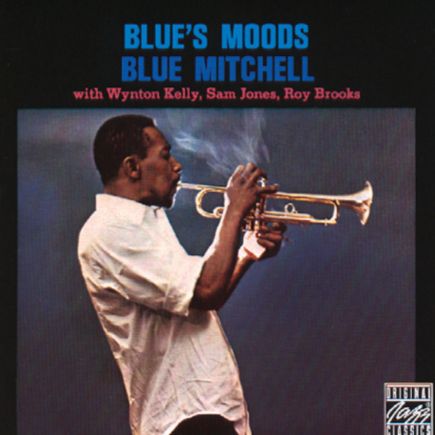Blue Mitchell, l’élégance lyrique du hard bop
Richard Allen ‘Blue’ Mitchell, trompettiste américain à la sonorité veloutée et au phrasé d’une clarté exemplaire, a su conjuguer virtuosité et retenue, sophistication harmonique et lyrisme spontané. Son parcours, à la croisée du hard bop, du soul jazz et du jazz fusion, témoigne d’une remarquable adaptabilité et d’une constance stylistique rare dans le paysage musical des années 1960 et 1970.
Né à Miami, Blue Mitchell grandit au cœur des musiques afro-américaines populaires: gospel, blues et rhythm & blues nourrissent ses premières expériences musicales. Très tôt, il se forge un jeu distinctif, souple et chantant, marqué par l’influence profonde de Clifford Brown. Après des débuts dans des orchestres locaux, il attire l’attention de musiciens établis et rejoint, en 1958, le quintette du pianiste Horace Silver — l’un des ensembles phares du hard bop.
Entre 1958 et 1964, Blue Mitchell enregistre avec Silver plusieurs albums devenus des piliers du genre, notamment Blowin’ the Blues Away (1959) et Song for My Father (1965). Son jeu y allie swing, précision rythmique et une expressivité retenue qui souligne le caractère mélodique du répertoire. Aux côtés de Junior Cook, Gene Taylor et Roy Brooks, il contribue à définir une esthétique où le groove rencontre la sophistication harmonique — une marque durable du style Blue Note.
Après son départ du groupe de Silver, Blue Mitchell fonde son propre quintette, réunissant notamment Chick Corea, Al Foster et Junior Cook. Avec cette formation, il enregistre plusieurs albums, dont The Thing to Do (1964) et Down with It! (1965), salués pour leur cohésion et leur inventivité mélodique. Ces disques confirment sa maîtrise de la trompette dans un registre plus personnel, empreint d’un lyrisme discret et d’une chaleur communicative.
À la fin des années 1960, Blue Mitchell explore d’autres horizons: il se produit avec l’orchestre de Ray Charles (1969-1971), puis rejoint le groupe du bluesman britannique John Mayall, participant activement aux albums Jazz Blues Fusion (1972) et Movin’ On (1973). Cette période marque un tournant vers des sonorités plus électriques et fusionnelles, sans que Mitchell perde sa rigueur mélodique ni sa sensibilité de jazzman.
Artiste d’équilibre et de finesse, Blue Mitchell se distingue de ses contemporains plus flamboyants, tels Lee Morgan ou Freddie Hubbard, par une approche intériorisée et chantante: attaque douce, vibrato mesuré, legato expressif. Sa trompette, à la fois claire et profonde, traduit un sens rare de la nuance et du phrasé.
Blue Mitchell, la elegancia lírica del hard bop
Richard Allen ‘Blue’ Mitchell, trompetista estadounidense de sonido aterciopelado y fraseo de una claridad ejemplar, supo combinar virtuosismo y contención, sofisticación armónica y lirismo espontáneo. Su trayectoria, en la encrucijada del hard bop, el soul jazz y el jazz fusión, refleja una notable capacidad de adaptación y una coherencia estilística poco común en el panorama musical de las décadas de 1960 y 1970.
Nacido en Miami, Blue Mitchell creció en el corazón de las músicas afroamericanas populares: el góspel, el blues y el rhythm & blues alimentaron sus primeras experiencias musicales. Muy pronto desarrolló un estilo propio, flexible y melódico, profundamente influido por Clifford Brown. Tras sus inicios en orquestas locales, llamó la atención de músicos consagrados y en 1958 se incorporó al quinteto del pianista Horace Silver, uno de los conjuntos más influyentes del hard bop.
Entre 1958 y 1964, Mitchell grabó con Silver varios álbumes que se convirtieron en pilares del género, entre ellos Blowin’ the Blues Away (1959) y Song for My Father (1965). Su interpretación combina swing, precisión rítmica y una expresividad contenida que resalta el carácter melódico del repertorio. Junto a Junior Cook, Gene Taylor y Roy Brooks, contribuyó a definir una estética donde el groove se encuentra con la sofisticación armónica, sello distintivo del estilo Blue Note.
Tras dejar el grupo de Silver, Mitchell formó su propio quinteto, reuniendo a músicos como Chick Corea, Al Foster y Junior Cook. Con esta formación grabó varios álbumes, entre ellos The Thing to Do (1964) y Down with It! (1965), elogiados por su cohesión e inventiva melódica. Estos discos consolidaron su dominio de la trompeta en un registro más personal, marcado por un lirismo discreto y una calidez comunicativa.
A finales de los años sesenta, Blue Mitchell exploró nuevos horizontes: actuó con la orquesta de Ray Charles (1969-1971) y luego se unió al grupo del bluesman británico John Mayall, participando activamente en los álbumes Jazz Blues Fusion (1972) y Movin’ On (1973). Este período marcó una transición hacia sonoridades más eléctricas y fusionadas, sin que Mitchell perdiera su rigor melódico ni su sensibilidad de jazzman.
Artista de equilibrio y sutileza, Blue Mitchell se distinguió de sus contemporáneos más brillantes, como Lee Morgan o Freddie Hubbard, por una aproximación introspectiva y cantabile: ataque suave, vibrato medido y legato expresivo. Su trompeta, clara y profunda, revela un raro sentido de la matización y del fraseo.
Blue Mitchell, l’eleganza lirica dell’hard bop
Richard Allen ‘Blue’ Mitchell, trombettista statunitense dal suono vellutato e dal fraseggio di esemplare chiarezza, seppe unire virtuosismo e misura, raffinatezza armonica e lirismo spontaneo. Il suo percorso, al crocevia tra hard bop, soul jazz e jazz fusion, rivela una notevole capacità di adattamento e una coerenza stilistica rara nel panorama musicale degli anni Sessanta e Settanta.
Nato a Miami, Blue Mitchell cresce immerso nelle musiche afroamericane popolari: gospel, blues e rhythm & blues nutrono le sue prime esperienze musicali. Fin da giovane sviluppa uno stile personale, flessibile e melodico, fortemente influenzato da Clifford Brown. Dopo gli inizi in orchestre locali, attira l’attenzione di musicisti affermati e nel 1958 entra a far parte del quintetto del pianista Horace Silver, una delle formazioni più rappresentative dell’hard bop.
Tra il 1958 e il 1964, Mitchell incide con Silver diversi album diventati capisaldi del genere, tra cui Blowin’ the Blues Away (1959) e Song for My Father (1965). Il suo stile unisce swing, precisione ritmica e un’espressività controllata che esalta il carattere melodico del repertorio. Accanto a Junior Cook, Gene Taylor e Roy Brooks, contribuisce a definire un’estetica in cui il groove incontra la sofisticazione armonica, marchio distintivo dello stile Blue Note.
Dopo aver lasciato il gruppo di Silver, Mitchell fonda il proprio quintetto, con musicisti come Chick Corea, Al Foster e Junior Cook. Con questa formazione registra diversi album, tra cui The Thing to Do (1964) e Down with It! (1965), lodati per la loro coesione e inventiva melodica. Questi lavori confermano la sua padronanza della tromba in un registro più personale, pervaso da un lirismo discreto e da un calore comunicativo.
Alla fine degli anni Sessanta, Blue Mitchell esplora nuovi orizzonti: suona con l’orchestra di Ray Charles (1969-1971) e successivamente si unisce al gruppo del bluesman britannico John Mayall, partecipando attivamente agli album Jazz Blues Fusion (1972) e Movin’ On (1973). Questo periodo segna una svolta verso sonorità più elettriche e fusion, senza che Mitchell perda la sua finezza melodica né la sua sensibilità jazzistica.
Artista di equilibrio e raffinatezza, Blue Mitchell si distingue dai suoi contemporanei più brillanti, come Lee Morgan o Freddie Hubbard, per un approccio introspettivo e cantabile: attacco morbido, vibrato misurato e legato espressivo. La sua tromba, chiara e profonda, rivela un raro senso della sfumatura e del fraseggio.
Blue Mitchell: the lyrical elegance of hard bop
Richard Allen ‘Blue’ Mitchell, an American trumpeter known for his velvety tone and crystal-clear phrasing, masterfully combined virtuosity with restraint, harmonic sophistication with spontaneous lyricism. His career, at the crossroads of hard bop, soul jazz, and jazz fusion, reflects remarkable adaptability and a rare stylistic consistency within the musical landscape of the 1960s and 1970s.
Born in Miami, Blue Mitchell grew up surrounded by the sounds of African American popular music — gospel, blues, and rhythm & blues shaped his early experiences. He soon developed a distinctive, fluid, and singing style, deeply influenced by Clifford Brown. After early work in local orchestras, he caught the attention of established musicians and, in 1958, joined pianist Horace Silver’s quintet — one of the defining groups of the hard bop era.
Between 1958 and 1964, Mitchell recorded with Silver on several albums that became genre landmarks, including Blowin’ the Blues Away (1959) and Song for My Father (1965). His playing blended swing, rhythmic precision, and a restrained expressiveness that emphasized the melodic character of the music. Alongside Junior Cook, Gene Taylor, and Roy Brooks, he helped shape an aesthetic where groove met harmonic sophistication — a lasting hallmark of the Blue Note sound.
After leaving Silver’s group, Mitchell formed his own quintet with musicians such as Chick Corea, Al Foster, and Junior Cook. With this ensemble, he recorded several acclaimed albums, including The Thing to Do (1964) and Down with It! (1965), praised for their cohesion and melodic inventiveness. These recordings confirmed his mastery of the trumpet in a more personal register, characterized by understated lyricism and a warm, communicative tone.
In the late 1960s, Blue Mitchell explored new musical directions: he performed with Ray Charles’s orchestra (1969–1971) and later joined British bluesman John Mayall’s band, contributing to the albums Jazz Blues Fusion (1972) and Movin’ On (1973). This period marked a shift toward more electric and fusion-oriented sounds, without sacrificing his melodic precision or jazz sensibility.
An artist of balance and refinement, Blue Mitchell distinguished himself from more flamboyant contemporaries such as Lee Morgan or Freddie Hubbard through an introspective, song-like approach — soft attack, measured vibrato, and expressive legato. His trumpet voice, at once clear and resonant, revealed a rare sensitivity to nuance and phrasing.


